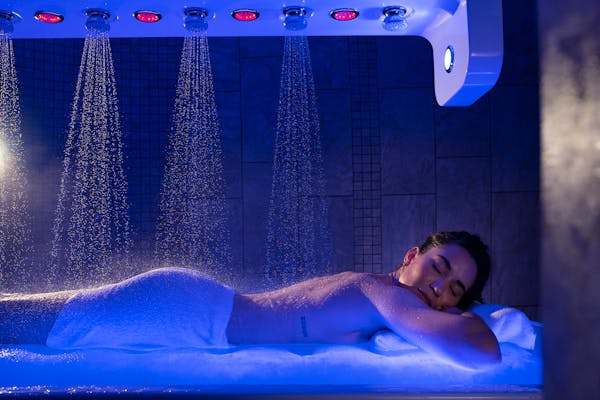Wellness retreats are on the rise in the Midwest, a post-COVID phenomenon
At Sundara Inn & Spa in Wisconsin Dells, guests show up for dinner wearing spa-issued robes and flip-flops, their faces ruddy from a day spent hot tubbing, their moods chill from yoga or meditation classes. They're not out to impress, but to retreat from the real world and its stresses, if only for a day or an overnight trip.
The situation is the same about two hours east at Kohler Waters Spa, where a recent tour revealed a half-dozen people who seemed to have dozed off while reading on thickly-cushioned chaise lounges. Others rotated through a hot tub/sauna/steam room/cold plunge circuit, which both soothes and reinvigorates. Still more sat in a pool beneath a pounding waterfall, letting it beat against tense backs and necks.
Sundara's general manager, John Morris, says that as COVID restrictions eased, people initially returned to his resort because they were stir-crazy and wanted to see a different set of four walls.
"As time went on, they seemed to need a break from the stress in the world, whether in response to George Floyd or the war in Ukraine," Morris says.
They may also have learned the importance of taking care of themselves during the pandemic, according to Nikki Miller, director of Kohler Waters Spa.
"COVID forced people to realize how much they needed wellness care, how much they needed to be touched, how much they needed to connect with other people, " she says. "The question now is, how do they implement this in their life? We're seeing that after two years of home self-care, they're planning trips, maybe with one friend, or with a group of family members."
Across the world, wellness tourism has rebounded post-pandemic and is on track to boom. The nonprofit Global Wellness Institute forecasts that the market will reach $1.3 trillion by 2025, and ranks the United States as the leader in the wellness industry overall.
Minnesota is experiencing growth in the sector, too, says Amy Barrett, communications manager for Explore Minnesota, the state's department of tourism.
Related content
"We don't track it as a separate category, but anecdotally we see the number of wellness travel offerings rising," Barrett says.
Of course, a retreat from daily life to refresh mind, body and spirit doesn't have to involve great distances. The Twin Cities has seen Wellness Paradigm, focused on communities of color who have not always been welcome in holistic health spaces, Watershed Spa, offering a communal bathing experience, and the Four Seasons' luxury spa come on the scene in the past year.
There's no sign of slowing, either. About 20 years ago, wellness travel and treatments were seen as a luxury for the elite. Now, Miller says, there's a greater understanding that wellness, in many forms, is for everyone.
"It's a part of life, and people have to find the time and space, and give themselves permission, to fit it in," Miller says. That could mean planning a walk with your partner or setting aside a half-hour a day to read or meditate.
What's next for the industry? Addressing America's poor sleeping habits and chronic lack of sleep.
"We're working on a sleep program now," Miller says.

